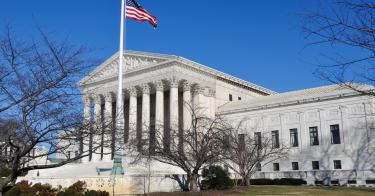Many Americans would be surprised to learn that a series of Supreme Court decisions allow officials in administrative agencies—rather than judges—to have the final say in interpreting statutes and rules.
Administrative agencies touch on nearly every aspect of Americans’ daily lives—from highways to electricity to health, and often with limited supervision from the other branches of government. All three branches of government have acknowledged the problems posed by unaccountable government bureaucrats who perform legislative, executive, and judicial functions.
Congress has its Article I Project to regain authority lawmakers have ceded to agencies over the decades, and President Donald Trump is requiring agencies to cut two old regulations before enacting any new ones.
Now it’s time for the Supreme Court to fix the problem it created when it mandated deference to administrative agencies.
In that series of decisions, the Supreme Court turned on its head Marbury v. Madison’s declaration that it is “emphatically the province and duty of the judicial department to say what the law is.”
The high court held in Chevron v. National Resources Defense Council that when reviewing an administrative agency’s interpretation of laws it is charged with carrying out, judges should defer to the agency’s judgment if the law is not clear and the agency’s interpretation is reasonable.
Decisions in Bowles v. Seminole Rock & Sand Co. and Auer v. Robbins require judges to defer to an agency’s interpretation of its own regulations unless that interpretation is plainly erroneous or inconsistent. Under National Cable & Telecommunications Association v. Brand X Internet Services, an agency’s interpretation of a statute can supersede a court’s interpretation, and City of Arlington v. FCC requires courts to defer to an agency’s jurisdictional determinations.
Taken together, these decisions stack the deck in favor of agencies. They require judges to “bow to the nation’s most powerful litigant, the government, for no reason other than it is the government,” as 3rd Circuit Judge Kent Jordan wrote in a concurring opinion last year.
Several Supreme Court justices have expressed concerns about these deference doctrines and indicated their interest in chipping away at Seminole Rock and Auer, in particular.
Justice Clarence Thomas frequently has commented on the constitutional problem created by both Seminole Rock and Auer. In a 2015 concurring opinion, Thomas explained that “giving legal effect” to an agency’s interpretation of regulations “effects a transfer of the judicial power” to the agency.
In the same case, Justice Samuel Alito wrote that he would like to explore “the validity of Seminole Rock” and the “aggrandizement of the power of administrative agencies.”
Chief Justice John Roberts also indicated that he “await[s] a case in which the issue is properly raised and argued.” Though Roberts was more guarded in his views than some of his colleagues, he appears to be open to the possibility of revisiting—and potentially reversing—Seminole Rock and Auer.
Justice Neil Gorsuch wrote a powerful concurring opinion when he was an appeals court judge, arguing that the Chevron decision is “difficult to square with the Constitution.” Though the case addressed judges deferring to agency interpretation of statutes, his criticisms apply with equal force to judges deferring to agency interpretation of regulations.
The Supreme Court justices won’t have to look far to find such a case. A petition currently pending before them squarely presents the opportunity to review Seminole Rock and Auer.
In Garco Construction Inc. v. Secretary of the Army, a construction company that had a contract with the U.S. Army Corps of Engineers to build Air Force housing in Montana is seeking to recoup extra costs it incurred due to the Corps’ contradictory interpretations of an applicable regulation. The company lost in the lower courts (with the appeals court deferring to the government’s interpretation of the regulation) and asked the Supreme Court to take up the case.
The justices will have a chance to review and discuss this petition on Friday, Jan. 5, their first conference of 2018.
With any luck, the court will agree to hear the Garco case and heed the words of the late Justice Antonin Scalia, who said a government agency “is free to interpret its own regulations,” but “courts will decide—with no deference to the agency—whether that interpretation is correct.”
The rationale for Seminole Rock and other deference doctrines is crumbling. It’s time for the Supreme Court to take back its authority to say what the law is.
This piece originally appeared in The Daily Signal



